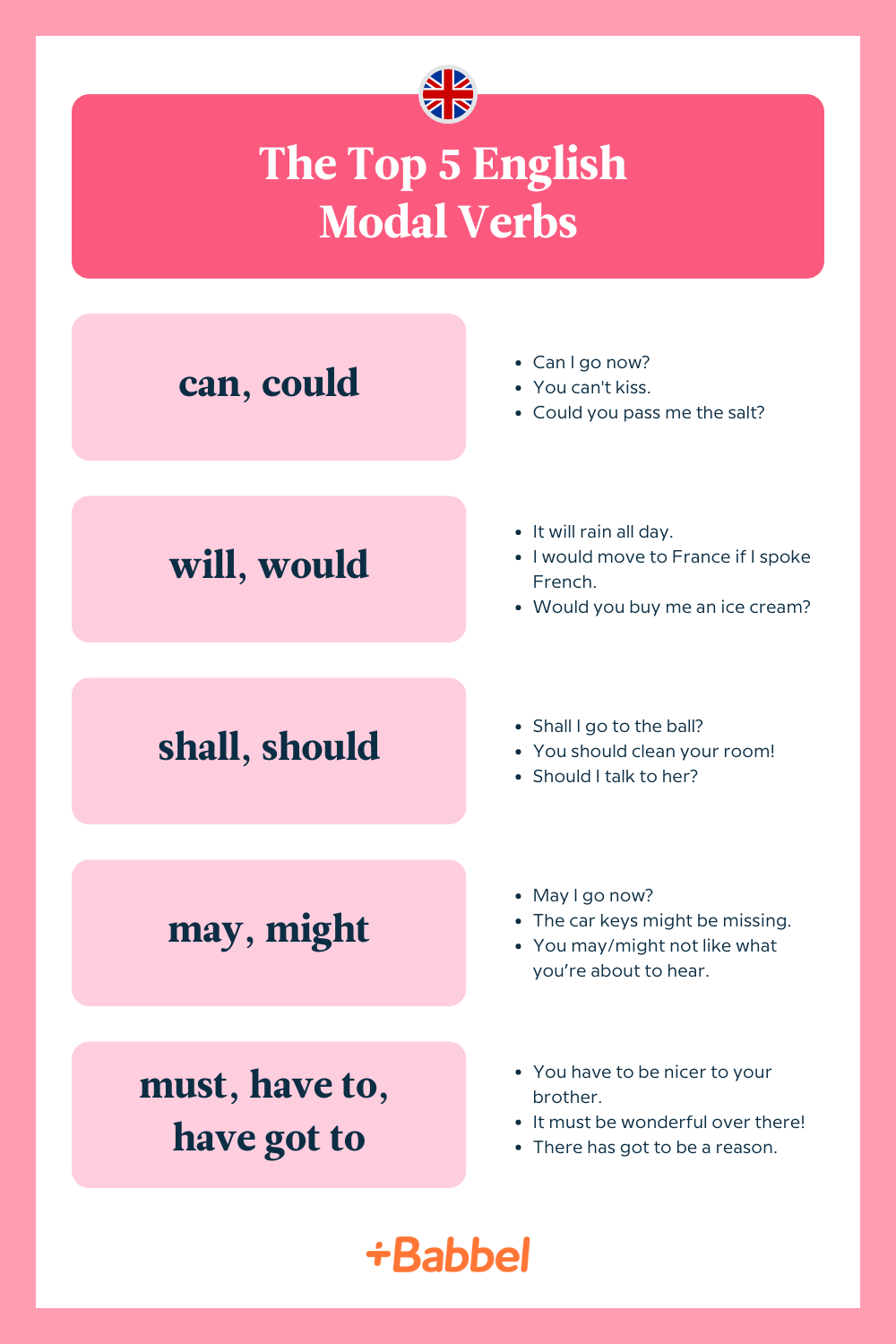Are you wondering what on Earth modal verbs are? What do they look like, when should you use one and what’s so “modal” about them anyway? If you are, then you’ve come to the right place! In this article, you’ll learn how to wow your English-speaking friends with your flawless mastery of English modal verbs.
In brief, modal verbs (which we also call “modal auxiliaries”) express degrees of possibility or desirability. It’s that simple! In the first case, they tell you how likely something is: if something is certain, possible or impossible. In the second sense, we use them to do things like ask for permission, give orders, offer recommendations and make requests.
So, what is modality in English? Well, this group of verbs are “modal” because they alter the mood of a statement or question. When we add them, they change the flavor of what’s being said. In this sense, you can think of modal verbs as a selection of herbs and spices. Compare these two statements:
- “I write.”
- “I can write.”
In the first, simple statement, the verb describes the action I’m doing. But in the second, where the modal verb “can” is placed before the infinitive form of the verb “write,” the meaning of the statement is radically altered. I’m telling you that I’m able to do something — expressing possibility!
And how do we use them in a sentence? As a rule of thumb they go before the other verb, which is in the infinitive. If you want to negate the modal verb, you simply drop a “not” (often shortened to -n’t) right after it. Here with the modal verb “can” again:
- “I can swim.”
- “I can’t swim.”
Easy, right?
A number of the modal verbs come in pairs. One for the present and one (called “preterite”) that’s often used for the past, for the subjunctive mood and to form conditional sentences. More about that later!
Oh and one last thing: you don’t need to conjugate modal verbs (I hear a sigh of relief). That is, you don’t add an -s in the third person singular like you do with other verbs.
- Correct: “She can sing!”
- Incorrect: “She cans sing!”
So, that’s how you do it. Now let’s look at the main modal verbs in more detail so you can spice up your English. We’ll start with this helpful infographic about the main five, but keep scrolling for more detailed information on the big eight.

Common English Modal Verbs
1. “Can” And “Could”
| I can | we can |
| you can | |
| she/he/it can | they can |
We know that modal verbs don’t change their form, so we don’t need to list all the pronouns. And as stated, the verb that follows the modal is in the infinitive form, such as here (in bold):
- “I can jump.”
- “They can talk.”
- “You can’t kiss.”
As you can see from these examples, “can” conveys certainty.
Note that with a question, such as “Can I go now?,” the subject-verb word order is inverted so that the modal comes first.
“Could” is the preterite partner of “can,” which is used for the following:
- Talk about the past: “I could jump.”
- Form conditional sentences (in which, of course, things are much less certain), such as: “He could wear leather trousers if he had better legs!”
- Make polite requests: “Could you pass me the salt, darling?”
2. “Will” And “Would”
| I will, I would | we will, we would |
| you will, you would | |
| he/she/it will, he/she/it would | they will, they would |
“Will” is an English modal verb that’s very sure of itself: you use if you want to tell someone that something is certain to happen, or ask if something is definitely going to happen:
- “Will it rain all day?”
- “It will rain all day!”
- “Will she win the race?”
- “She will win the race!”
So you see here that “will” leaves no room for doubt. It will definitely rain all day and she will definitely win the race!
Yet if you use “would” (like the aforementioned “could”), it makes things far less certain. You can use it in the following cases:
- Form conditional sentences: “She would have won the race if she were fitter.”
- Ask polite questions: “Would you buy me an ice cream?”
Note that if someone is annoying you, you can also veil an order in a polite-sounding “would” question: “Would you please go away?” (For extra emphasis, stress the “please.”)
3. “Shall” And “Should”
| I shall, I should | we shall, we should |
| you shall, you should | |
| he/she/it shall, he/she/it should | they shall, they should |
The modal verb “shall” is used to give orders and make predictions with a degree of certainty.
- “Shall I go to the ball?”
- “You shall (go to the ball)!”
However, the less dominant “should” introduces a more advisory tone.
- “Should I go to the ball?”
- “Yes, you should.”
Here the question of which to use hangs on both register and meaning. “Shall” is a touch more formal and much more definite, so you use it to give orders and make predictions of which you’re 100 percent sure. In this sense, it’s interchangeable with “will.” And as we saw above, “should” is used for making recommendations.
4. “May” And “Might”
| I may, I might | we may, we might |
| you may, you might | |
| he/she/it may, he/she/it might | they may, they might |
“May” and its companion “might” are both rather timid, uncertain creatures, and can be used to great effect if you want to do any of the following.
- Make polite requests: “May I go now?”
- Offer advice: “You may want to talk to a priest.”
- Be evasive: “The car keys may be missing.”
Note that “may” and “might” are, theoretically, interchangeable. For example:
- “You may/might not like what you’re about to hear.”
- “Might/may my mother use the bathroom?”
Lastly, “may” and “might” can also be used to form some types of conditional sentences: “They might/may not have met if they didn’t both love ballroom dancing.”
5. “Must,” “Have To” And “Have Got To”
| I must, I have to, I’ve got to | we must, we have to, we’ve got to |
| you must, you have to, you’ve got to | |
| he/she/it must, he/she/it has to, he/she/it has got to | they must, they have to, they’ve got to |
If you want to give someone a firm order or express that something absolutely has to happen, you should use the modal “must” theoretically. “Must” is a tricky creature because in regular speech people tend to give orders using “have to” or, in the United Kingdom, “have got to” instead.
- “You have to be nicer to your brother.”
- “You’ve got to be nicer to your brother.”
It’s not grammatically incorrect to use “must” when giving firm orders or advice, it just sounds rather old-fashioned or formal to native speakers. When talking about the past, you use “had to.” For example, “She had to be nicer to her brother.” Also note, that “have got to” is one exception to the “no conjugations” rule, because it changes to “has got to” in the third-person singular: “He has got to run to the supermarket.”
So when do we use “must”?
- When giving an order or advice to ourselves: “I must be nicer to my brother.”
- When making statements: “It must be wonderful.”
- And with negation, where “must” is followed by “not” or -n’t and then the infinitive: “You mustn’t tease your brother!”
Bonus English Modal Verbs
Lastly, we have a few other verbs that are sometimes used as modals. They’re less common, but it doesn’t hurt to know about them.
6. “Ought To” And “Had Better”
| I ought to, I had better | we ought to, we’d better |
| you ought to, you’d better | |
| he/she/it ought to, he/she/it had better | they ought to, they’d better |
“Ought to” is used like “should” to give advice or recommendations. “Had better” is used in the same way (“had” is usually shortened to -’d).
- “You ought to stop giving advice!”
- “They’d better quit complaining!”
Using either of these can come across as quite stern or passive-aggressive, depending on your tone of voice. You ought to use them wisely!
7. “Need”
As a modal verb “need” is used to form questions and negative statements in the same way as “must” and “have to.”
- “Need I go on?” (“Must I go on?”)
- “You needn’t bore me with the details.” (You don’t have to bore me with the details.”)
8. “Dare”
Just like “need,” “dare” as a modal verb is used for questions and negative statements.
- “Dare I go on?”
- “They daren’t cross that wobbly old bridge.”
“Dare” has the added benefit of introducing a sense of risk and drama into any utterance.
So, there you have it, all you need to know about English modal verbs, in a nutshell!











